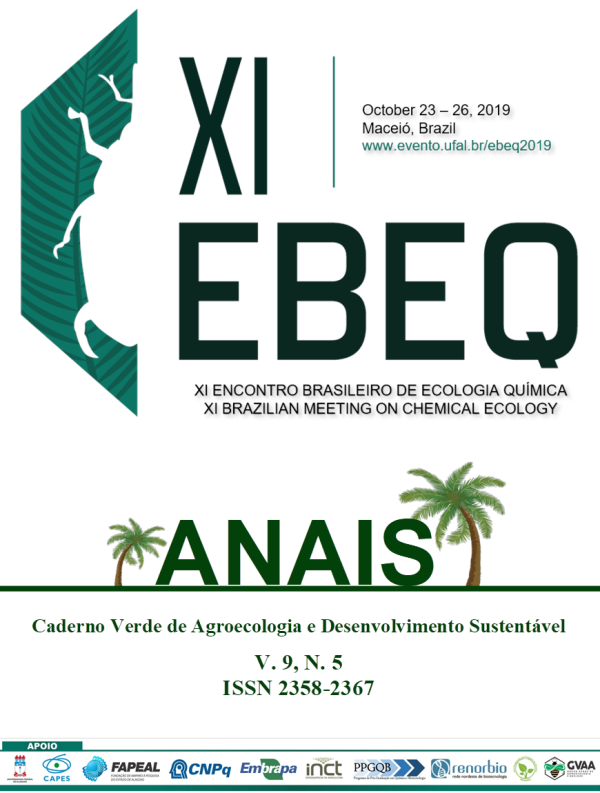SPOTTED-WING DROSOPHILA (Drosophila suzukii) ATTACK AND FRUIT VOLATILE PROFILES: IN SEARCH FOR PARASITOID CHEMICAL CUES
Palavras-chave:
PARASITOIDS, BERRIES VOLATILES, INTEGRATED PEST MANAGEMENTResumo
The spotted-wing Drosophila (SWD), Drosophila suzukii, has become a major pest of berries and cherries worldwide. Originally from Asia, the insect has invaded Europe, North America and more recently South America, including austral regions in the southern cone. Different from other drosophilids that attack rotten fruit, SWD flies can colonize fruits that are still in the maturation process, hence of commercial value. Within potential integrated pest management methods, biological control with established parasitoid populations appears as an alternative worth exploring. While searching for suitable hosts, parasitoids of insects that develop inside the fruit may use host-related chemical cues such as volatile organic compounds (VOCs) released from the attacked fruit. Here we report our preliminary findings of blueberry VOCs prior and after colonization by SWD. Working with commercial blueberries, we sampled volatiles three times in relation to oviposition by SWD females: one day before (T0), one day after (T1) and one week after (T2) the attack. VOCs were analyzed by GC-MS and were mainly composed in T0 and T1 by methyl and ethyl 3-methylbutanoate, and by (E)-caryophyllene, with smaller amounts of 2-hexanone and n-decane only in T1. In T2 the VOC profile changed dramatically both qualitative and quantitatively, and is dominated by isopentyl acetate, ethyl 3-methylbutanoate, phenyl ethyl acetate and phenyl ethyl acetate alcohol, among other compounds. The differences in VOCs from attacked and non-attacked blueberries are still under analysis. The results are discussed in relation to the potential finding of wild drosophilid parasitoids, here first reported for Uruguay that may be able to detect chemical cues from SWD-infested fruits.Downloads
Publicado
Como Citar
Edição
Seção
Licença
Termo de cessão de direitos autorias
Esta é uma revista de acesso livre, em que, utiliza o termo de cessão seguindo a lei nº 9.610/1998, que altera, atualiza e consolida a legislação sobre direitos autorais no Brasil.
O(s) autor(es) doravante designado(s) CEDENTE, por meio desta, publica a OBRA no Caderno Verde de Agroecologia e Desenvolvimento Sustentável, representada pelo Grupo Verde de Agroecologia e Abelhas (GVAA), estabelecida na Rua Vicente Alves da Silva, 101, Bairro Petrópolis, Cidade de Pombal, Paraíba, Brasil. Caixa Postal 54 CEP 58840-000 doravante designada CESSIONÁRIA, nas condições descritas a seguir:
O CEDENTE declara que é (são) autor(es) e titular(es) da propriedade dos direitos autorais da OBRA submetida.
O CEDENTE declara que a OBRA não infringe direitos autorais e/ou outros direitos de propriedade de terceiros, que a divulgação de imagens (caso as mesmas existam) foi autorizada e que assume integral responsabilidade moral e/ou patrimonial, pelo seu conteúdo, perante terceiros.
O CEDENTE mantêm os direitos autorais e concedem à revista o direito de divulgação da OBRA, com o trabalho simultaneamente licenciado sob a Licença Creative Commons do tipo atribuição CC-BY.
O CEDENTE têm autorização para distribuição não-exclusiva da versão do trabalho publicada nesta revista.
O CEDENTE têm permissão e são estimulados a publicar e distribuir seu trabalho online (ex.: em repositórios institucionais ou na sua página pessoal) a qualquer ponto antes ou durante o processo editorial, já que isso pode gerar alterações produtivas, bem como aumentar o impacto e a citação do trabalho publicado.










